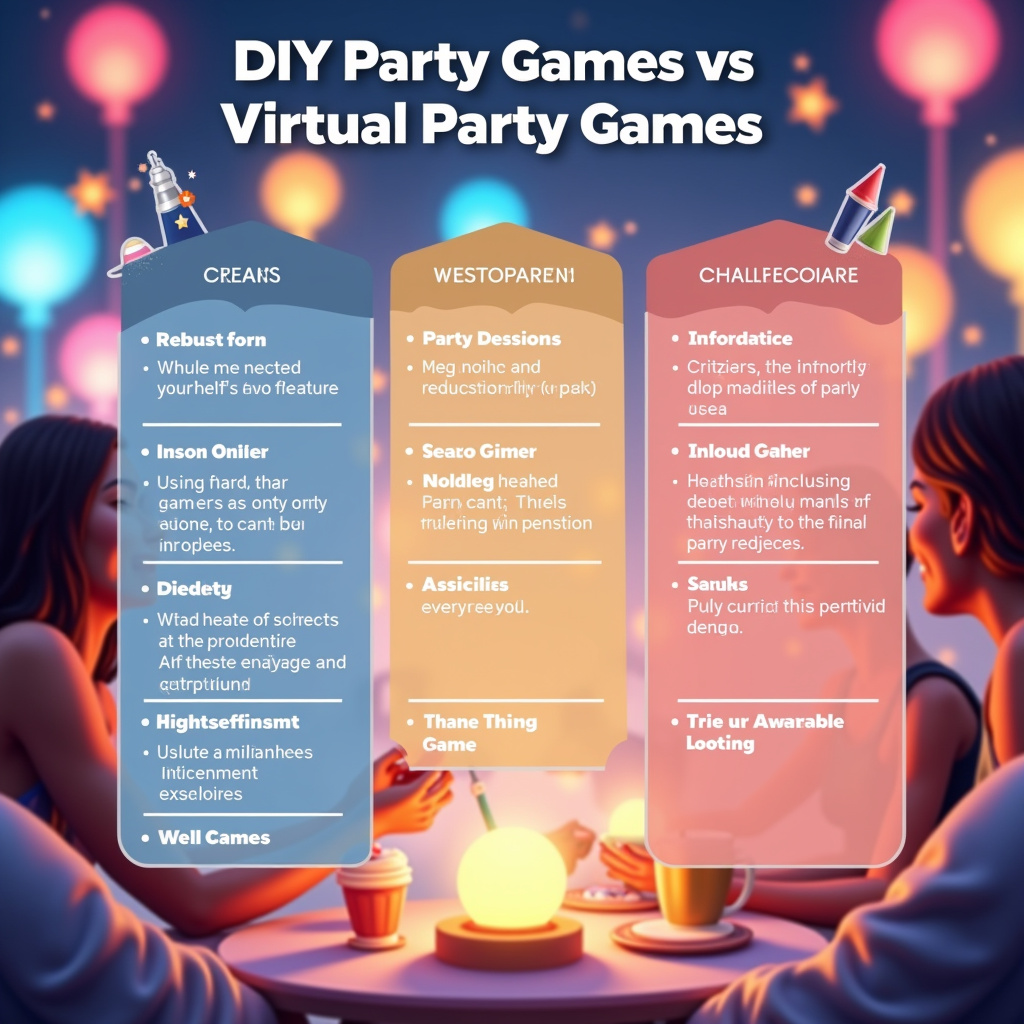DIY Party Games vs Virtual Party Games: A Complete Comparison
Planning a great party, whether it’s a milestone birthday or just a fun get-together, always comes down to the entertainment. If you’re trying to nail down the perfect party ideas, you’ve likely hit the classic crossroads: should you lean into the hands-on fun of DIY party games for adults or embrace the convenience of modern virtual party game ideas? This comparison is for anyone navigating the planning stages, from those working with a tight budget looking for cheap party decorations to hosts juggling guests across different locations. We’re breaking down the pros, cons, and perfect use cases for both approaches so you can host an unforgettable event.
Setting the Stage: Understanding the Two Contenders
Before we dive into the head-to-head, let’s quickly define what we mean by these two categories.
Option 1: The Charm of DIY In-Person Games
DIY party games are the heart and soul of traditional hosting. They involve physical setup, tactile interaction, and often require you to create the components yourself. Think charades variations, homemade trivia, or setting up a photo booth with props you crafted last night. This style is perfect for intimate gatherings, like planning low-cost birthday themes or executing small space party layout ideas where physical engagement is key.
Option 2: The Flexibility of Virtual Games
Virtual party games leverage technology to connect remote guests. This spans everything from dedicated online platforms (like Jackbox Games) to using video conferencing tools for specialized activities, such as hosting an interactive murder mystery party kits online. This format shines when geographical distance is a factor, making it ideal for long-distance celebrations or when you need a robust solution for a last minute party planning guide.
Feature-by-Feature Showdown
To make an informed choice, we need to compare these options across the practical elements of party planning.

1. Features and Capabilities
DIY games offer boundless creativity. You can tailor every aspect to your specific theme, whether it’s a retirement party themes for men involving old photos or a sophisticated evening requiring elegant dinner party themes where the game itself is subtly integrated.
Virtual games, conversely, offer built-in structure and automation. Many platforms handle scoring, question randomization, and sometimes even audio/visual components seamlessly, which is a huge plus when you’re trying to manage a complex themed cocktail party menu simultaneously.
2. Pricing and Value Analysis
This is where the contrast is stark. DIY games are almost always the winner on pure cost savings. If you utilize a free party planning checklist and raid your recycling bin for materials, your cost for entertainment can be near zero, aligning perfectly with those aiming for cheap party decorations.
Virtual games usually involve a software purchase, subscription, or the cost of the online kit itself. While you might save on physical supplies and venue rental, the upfront software cost can range from $5 to $50 or more per event.
3. Ease of Setup and Execution
Setting up DIY games requires time and physical space. You need to ensure you have the right lighting, enough space for movement, and all your homemade components are ready. For parties aimed at younger crowds, like teenager party themes at home, this physical setup is often part of the fun.
Virtual games are generally faster to deploy if you are comfortable with the technology. The setup time is mostly dedicated to sending out links and ensuring everyone has the necessary hardware (a phone or tablet often doubles as the controller). However, technical glitches—a lagging connection or someone unfamiliar with the platform—can derail the flow quickly.
4. Performance and Engagement Level

In-person, DIY games rely heavily on the host’s energy and the chemistry of the group. When they land, the engagement is incredibly high—laughter is louder, competition is fiercer, and the shared experience is tangible.
Virtual engagement can sometimes feel fragmented. While great for large groups spread across time zones, the lack of physical presence means you lose some of that spontaneous interaction. Success here relies on excellent video quality and a lively host to keep energy up.
5. Support and Community
DIY games rely on the vast, informal community knowledge found online (Pinterest, blogs, etc.). Support is organic—if your homemade trivia question is flawed, you can usually adjust it on the fly.
Virtual game platforms often have dedicated customer support, tutorials, and active user forums. If an interactive murder mystery party kit isn't loading correctly, you have a specific company to contact for technical assistance.
Pros and Cons at a Glance
| Feature | DIY In-Person Games | Virtual Party Games |
|---|---|---|
| Pros | High tactile engagement, extremely low cost, customizable to any theme. | Excellent for remote guests, automated scoring, minimal physical setup required. |
| Cons | Requires physical space, time-consuming setup, relies on guest proximity. | Can feel impersonal, requires stable internet, potential software costs. |
Use Case Recommendations: Which Path is Right for Your Party?
Choosing between DIY and virtual isn't about which is "better," but which is better suited to your current situation.

Choose DIY Games When:
- Budget is the absolute top priority: You are maximizing low-cost birthday themes and need entertainment that costs next to nothing.
- You have a strong, localized guest list: Everyone is in the same house or within easy walking distance.
- The theme demands interaction: Planning a small space party layout ideas around a physical challenge or craft element works best here.
- You love crafting: You enjoy the process of making the game components as much as playing the game itself.
Choose Virtual Games When:
- You have geographically dispersed guests: This is the only way to include loved ones who can't travel.
- You need a quick solution: You’re pulling together a last minute party planning guide and don't have time to craft elaborate physical games.
- The focus is on structured competition: Games like online trivia or digital escape rooms provide clear, automated winners.
- You are hosting a specific niche event: Many specialized kits, like complex interactive murder mystery party kits, are optimized for digital play.
The Final Verdict: Balancing Experience and Logistics
Ultimately, the best party entertainment blends engaging activities with manageable logistics.
If you are hosting a small, in-person gathering, investing time in thoughtful DIY party games for adults will almost always yield a warmer, more memorable atmosphere, especially when paired with smart cheap party decorations. The tangible connection you build through shared physical activity is hard to replicate through a screen.
However, in today's world, flexibility is golden. Virtual games are not a compromise; they are a powerful tool that allows celebration to happen regardless of distance. They are the perfect backbone for events where logistics outweigh the ability to gather everyone in one room.
Review your guest list, assess your available time, and look back at your free party planning checklist. Does your event prioritize physical presence and low cost, or wide accessibility and automated structure? Decide based on that answer, and you’ll have the perfect entertainment lined up!



